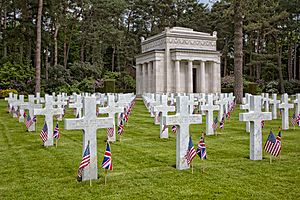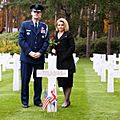Brookwood American Cemetery and Memorial facts for kids
Quick facts for kids Brookwood American Cemetery and Memorial |
|
|---|---|
| American Battle Monuments Commission | |

Memorial chapel and headstones
|
|
| Used for those deceased 1918 | |
| Established | 1918 |
| Location | near
Brookwood, Surrey
|
| Designed by | Egerton Swartwout and H.B. Cresswell |
| Total burials | 468 plus 563 commemorated |
|
Unknowns
|
41 |
| Burials by nation | |
|
United States
|
|
| Burials by war | |
| Statistics source: ABMC Brookwood web page | |
The Brookwood American Cemetery and Memorial is a special place in the United Kingdom. It is the only American military cemetery from World War I in the British Isles. This cemetery is about 28 miles (45 km) southwest of London.
It holds the graves of 468 American soldiers who died in World War I. Among them are 41 unknown servicemen. The American Battle Monuments Commission takes care of this important site. The cemetery covers about 4.5 acres (1.8 hectares). It is next to the larger Brookwood Military Cemetery.
History of the Cemetery
In 1922, the US government bought land next to the Brookwood Military Cemetery. They hired a company to help design and build this new American cemetery. A chapel and memorial were also part of the plan.
The chapel memorial opened in 1929. Inside, you can find the names of 563 missing Americans. Most of these brave people served in the United States Navy or United States Coast Guard. Their graves are often in the sea, so their names are honored here.
Most of the soldiers buried at Brookwood died in Great Britain or nearby waters. During World War I, American servicemen who passed away in London hospitals were brought here. After the war ended in 1918, bodies from other temporary sites across England, Scotland, and Ireland were also moved to Brookwood.
These were members of the American Expeditionary Forces. They lost their lives in England or the surrounding seas. For example, some victims from the sinking of the SS Tuscania in 1918 were reburied here. Also, many American victims of the HMS Otranto tragedy were moved to Brookwood.
When the Second World War began, the American cemetery became larger. American servicemen started to be buried there in April 1942. A special train service brought bodies from Devonport to Brookwood. By August 1944, over 3,600 bodies had been buried.
After this, new burials were stopped at Brookwood. American casualties were then buried at the Cambridge American Cemetery and Memorial. In 1948, the US servicemen buried at Brookwood during World War II were moved. Some were sent back to the United States if their families wished. Others were moved to the new cemetery near Cambridge.
Some US servicemen who had been buried at Brookwood were later moved to a different site. This site was called Oise-Aisne American Cemetery Plot E. This was a special place for certain US servicemen from World War II.
How the Cemetery Looks
The cemetery was designed by two architects, Egerton Swartwout and Harry Bulkeley Creswell. Swartwout also designed other important buildings in the United States.
At Brookwood, he arranged the cemetery into four areas for the 468 headstones. These areas are grouped around a flagpole. The headstones are made of beautiful white Carrara marble. They are shaped like a Latin cross or a Star of David.
Shrubs and trees like evergreens, oaks, and Scots pines frame the grave plots. Some old pine trees were kept to make the chapel area look nice. Colorful plants like rhododendrons, azaleas, and heather were also planted.
From 2015 to 2016, a lot of work was done at the cemetery. This was to get it ready for the 2016 Memorial Day Service. All the headstones were replaced to meet strict rules. The grounds were also improved, and new plants were added.
The Chapel
The chapel memorial was opened in 1929. It was also designed by Egerton Swartwout and Harry Bulkeley Creswell. You can find it on the northwest side of the cemetery. Above the entrance, a special message is carved: “PERPETUAL LIGHT UPON THEM SHINES.”
The chapel is a classic white stone building. It is made from Portland limestone. Inside, it is decorated with symbols related to religion, the military, and patriotism. The interior has soft, tan-colored stone. There is an altar, two oak benches, flags, and carved doorways.
There are 18 beautiful stained glass windows. They were designed by Reginald Hallward. Each window has the names of American States and Territories from 1918. You can also see symbols for the Army, Navy, Marine Corps, and Coast Guard.
The names of 563 missing Americans are carved into the chapel walls. Most of these people were lost at sea. Their bodies were never found or could not be identified. The names of all 115 crew members from the USCGC Tampa are on the walls. This ship was attacked in 1918, and everyone on board was lost.
The names of 21 men from the USS Alcedo are also there. This ship was hit by a torpedo in 1917. Additionally, the names of 11 men from the USCGC Seneca are listed. They were lost in 1918 while trying to help another ship.
Notable Names
Two brave Americans who received the Medal of Honor are honored at Brookwood American Cemetery. The Medal of Honor is the highest military award in the United States.
One of them is Gunner's Mate First Class Osmond Ingram. He was the first sailor to receive this award in World War I. On October 15, 1917, Ingram was on the USS Cassin. He saw a torpedo coming towards the ship. He tried to release the ship's depth charges to protect it.
Sadly, the torpedo hit the ship before he could finish. Ingram was killed by the explosion. His body was never found. His name is carved in gold on the chapel wall with other crewmen from the Cassin.
Another Medal of Honor recipient honored here is Gustav A. Sundquist. He fought in the Spanish–American War. He later drowned at sea on August 25, 1918.
Images for kids















